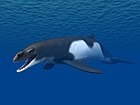Mauicetus
Appearance
| Mauicetus Temporal range: Late Oligocene.
| |
|---|---|
| Scientific classification | |
| Domain: | Eukaryota |
| Kingdom: | Animalia |
| Phylum: | Chordata |
| Class: | Mammalia |
| Order: | Artiodactyla |
| Infraorder: | Cetacea |
| Family: | Balaenopteridae (?) |
| Genus: | †Mauicetus Benham, 1939 |
| Type species | |
| †Lophocephalus parki Benham, 1937
| |
| Synonyms | |
|
Lophocephalus Benham, 1937 | |
Mauicetus is a genus of extinct baleen whale from the Late Oligocene of New Zealand.
Taxonomy
[edit]Mauicetus was originally named Lophocephalus by William Benham, but that name was already used for a beetle, and Benham provided the replacement name Mauicetus.[1][2] Three more species were named in 1956: M. brevicollis, M. lophocephalus, and M. waitakiensis.[3] Nowadays, Mauicetus parki is considered a stem-balaenopteroid, while M. lophocephalus and M. waitakiensis have been reclassified in Eomysticetidae, with M. lophocephalus and M. waitakiensis being assigned to Tokarahia and Tohoraata.[4][5][6]
References
[edit]- ^ W. B. Benham. 1937. On Lophocephalus, a new genus of zeuglodont Cetacea. Transactions and Proceedings of the Royal Society of New Zealand 67(1):1-7
- ^ W. B. Benham. 1939. Mauicetus: a Fossil Whale. Nature 143(3627):765
- ^ B. J. Marples. 1956. Cetotheres (Cetacea) from the Oligocene of New Zealand. Proceedings of the Zoological Society of London 126(4):565-580
- ^ Robert W. Boessenecker and R. Ewan Fordyce (2014). "A new Eomysticetid (Mammalia: Cetacea) from the Late Oligocene of New Zealand and a re-evaluation of ‘Mauicetus’ waitakiensis". Papers in Palaeontology. in press. doi:10.1002/spp2.1005.
- ^ STEEMAN, M. E. 2007. Cladistic analysis and a revised classification of fossil and recent mysticetes. Zoological Journal of the Linnean Society, 150, 875–894.
- ^ Robert W. Boessenecker and R. Ewan Fordyce (2015). "A new genus and species of eomysticetid (Cetacea: Mysticeti) and a reinterpretation of ‘Mauicetus’ lophocephalus Marples, 1956: Transitional baleen whales from the upper Oligocene of New Zealand". Zoological Journal of the Linnean Society. in press. doi:10.1111/zoj.12297.




